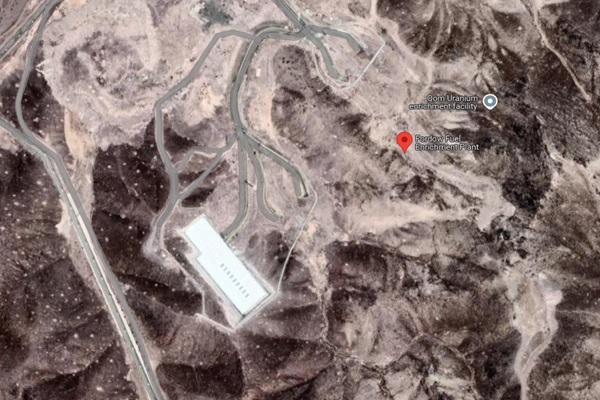.png)
Saibal Dasgupta is an author, veteran journalist, and noted China expert who has reported from Beijing since 2005 and contributes to global media and think-tanks.
June 20, 2025 at 4:25 AM IST
As tensions escalate between Iran and Israel, much of the world is watching the conflict as political spectacle. What remains dangerously under-examined is the possibility of radioactive fallout from a direct attack on Iran’s nuclear infrastructure, which could maim or kill tens of thousands and create a perilous precedent.
United States President Donald Trump has publicly considered bombing Iran’s Fordow nuclear site, buried deep beneath a mountain and fortified with layers of reinforced concrete. A strike would likely require 30,000-pound bunker-busting bombs deployed by B2 stealth bombers. “I may do it. I may not do it,” he said, his characteristic ambiguity cloaking the severity of such a decision. While his political base discourages foreign wars, there is little public reckoning with the risks of nuclear contamination.
Fordow, located 300 feet underground, is not just another military target. According to the International Atomic Energy Agency, it stores uranium enriched up to 60%, well above levels used for civilian energy but short of the 90% needed for weapons. No military has ever deliberately struck an active nuclear enrichment facility. An attack would normalise what has long been considered a red line and introduce irreversible consequences.
Any military escalation involving such sites risks radiological release with serious consequences for people and the environment. Beyond the immediate fallout, the implications for global nuclear stability are profound. The Geneva Conventions and their Additional Protocols prohibit attacks on civilian infrastructure, and legal scholars argue that nuclear facilities, unless actively used in combat, remain protected under international humanitarian law.
The International Committee of the Red Cross has repeatedly cautioned that striking nuclear sites could violate humanitarian law and result in catastrophic harm. It has expressed doubt that nuclear weapons could ever be used in line with legal and moral principles.
A strike on Iran’s facilities would also lower the bar for similar actions in future conflicts, whether in South Asia, the Korean Peninsula or elsewhere. The Stockholm International Peace Research Institute notes that introducing radioactive risk into conventional warfare undermines decades of nuclear restraint and weakens the threshold for escalation.
Alarm has grown in select quarters. Tulsi Gabbard, the United States Director of National Intelligence, warned in a recent video that the world stands closer to nuclear annihilation than ever before. She accused political leaders of fomenting tensions between nuclear powers. Trump, reportedly angered by her remarks, rejected her assessment and maintained that Iran is “very close” to building a bomb, contradicting Gabbard’s earlier testimony to Congress.
Despite the gravity of the situation, few Western governments have urged restraint. The IAEA has acknowledged the risks of radiological release but has avoided directly naming the United States. Expert opinion remains divided. Kelsey Davenport of the Arms Control Association believes that a successful strike on Fordow might result in limited radiation due to the fresh, unirradiated nature of the stored uranium. However, she warns that targeting a nuclear reactor, unlike an enrichment facility, would be a clear violation of international law and could trigger a regional catastrophe.
Alexey Likhachev, CEO of Russia's state-owned nuclear energy company, Rosatom, has warned that a strike on Iran's sole active nuclear reactor at Bushehr could trigger a Chernobyl-like disaster. He urged Tel Aviv to refrain from attacking the plant built in collaboration between Russia and Iran.
Scott Roecker of the Nuclear Threat Initiative agrees that Fordow’s underground construction might contain some of the fallout. Yet, he cautions that the strategic and symbolic consequences of breaking this taboo could extend far beyond Iran.
Iran’s leadership has responded with explicit threats. Supreme Leader Ayatollah Ali Khamenei warned that any American military intervention would result in irreparable damage. Deputy Foreign Minister Majid Takht-Ravanchi stated on CNN that Tehran would retaliate against American targets if the United States enters the war and argued that any strike on its nuclear infrastructure would breach international law.
Beyond Iran, more than 30 countries operate uranium-based nuclear power plants. Most are designed to provide clean and affordable energy, not to withstand missile or drone attacks. Unlike Fordow, many are not underground. The possibility of future sabotage, whether during wars or via terrorist strikes, is no longer hypothetical. The disasters at Chernobyl and Fukushima showed how even accidental failures can devastate populations and ecosystems for decades.
The Israel-Iran conflict is not just another geopolitical flare-up. It is a test of whether the global community still honours the principles of nuclear restraint. If this line is crossed, the rules of engagement may be rewritten in ways that blur the distinction between conventional warfare and existential risk.




